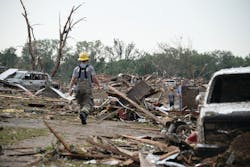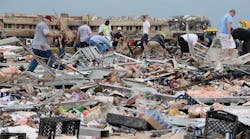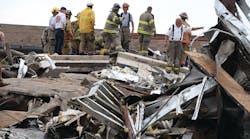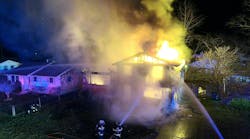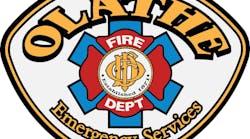Several challenges related to staging were identified in after-action meetings. Early in the response, multiple agencies established their own mobile command and staging areas. This led incoming resources to check in at the wrong locations and, without clear communication between the various command posts and staging areas, they were left with little instruction on where to go. All commanders agreed that a better solution would have been to co-locate all staging in a single area. This would have allowed face-to-face coordination between various agencies and staging officers and provided for the capability to build task forces and strike teams from a combination of agencies and jurisdictional resources.
“Incidents of this size need an INCIDENT staging area, not dozens of AGENCY staging areas,” Oklahoma State IMT program coordinator Troy German said.
Sending self-deployed resources away, however, became difficult. Many resources checking in were giving plausible explanations as to why they were deployed, but the staging manager had little opportunity to verify that with unified command. Many of these units came from great distances and were ready to work, even if for a short time. We read in command handbooks about the 12-hour operational period, but when fire apparatus and emergency vehicles of every size, shape and color are lined up for miles behind staging area, additional options must be identified.
One suggestion was to combine units from multiple agencies into task forces and assign them to shorter work periods (sometimes as little as four hours) to move resources out of staging. But before making adjustments to a shorter work period, incident managers must determine whether it would complicate the normal operational period planning process. If self-dispatched resources are not identified mutual aid partners or were not specifically requested through command, they should be returned home with instructions to prepare for a future operational period.
Another challenge related to staging was trying to collect the growing number of unassigned resources roaming the scene. As the incident progressed, law enforcement officers assigned to perimeter control were asked to help funnel these responders back to staging. Unfortunately, with the growing number of staging areas being identified, the perimeter control officers were sometimes unclear about which staging area to send them. Command should ensure that the exact location of resource staging is clearly communicated to all incoming units and law enforcement units assigned to control the perimeter. Another suggestion offered by law enforcement branch officers in the after-action meetings was to, whenever possible, locate staging areas outside the controlled perimeter.
Staging managers spent valuable time troubleshooting radio communications variations from multiple “home-based” systems. This complicated the ability to form task forces with the capacity to communicate with each other. Staging officers and local emergency management personnel alike were trying to build communications plans that could accommodate VHF, UHF, multiple 800 hybrids and patchwork systems. We tackled this problem by bringing a large case full of radios, batteries and charging devices provided by the local emergency manager to the command and staging areas. These radios were already programmed to operate with Moore’s communications system and were distributed to task force leaders when an assignment was given. Also, communications unit leaders worked closely with the unified command staff to establish an incident communications plan that eventually was followed by all personnel.
Perimeter control and security
One of the first incident objectives was to maintain a secure perimeter around the affected area. Calculating the tornado’s 17-mile-long destructive path by its average width of 1½ to two miles left an estimated perimeter of just under 38 linear miles. Fortunately, the entire 38 miles did not need to be controlled, and an initial outer perimeter was established of only about nine linear miles around an approximately 3½-square-mile section of the most affected areas.
Controlling citizens, traffic, media and sightseers in and out of this area quickly became an enormous task, and one that needed to be taken very seriously and with a great deal of “tact.” In Oklahoma, law enforcement personnel have learned from years of controlling tornado- and wildfire-ravaged areas that a fine line exists between establishing a “hard” perimeter for the protection of life and property and adding to the frustration of victims who have already lost so much. To accomplish this task, commanders used law enforcement strike teams each made up of five officers and a leader.
While operations commanders had set some early goals to establish strike teams, it took a while to get them organized. During the first hours, the scene was understandably chaotic with a largely undetermined damage area, a long list of self-deployed law enforcement officers, security guards and military-clad individuals responding to help. In one case, a local police officer was tasked to deny all access to a major intersection leading into Moore, while just a few blocks away a volunteer group of well-meaning Marines were directing traffic right into the area.
Early in the incident, state Highway Patrol troopers, Oklahoma County sheriff’s deputies and police officers from all over Oklahoma converged on Moore into “staging” locations established by each agency. As the incident progressed, the perimeter groups and patrol groups developed separate staging areas. This proved problematic when law enforcement personnel arriving on scene had to distinguish between the various staging areas. Several state and local law enforcement agencies from as far away as Arkansas and Mississippi converged on staging areas established by both the state Highway Patrol (east of the command post) and City of Moore (north of the command post) and found themselves bounced back and forth between staging areas.
Before a structured check-in process was established, police officers from outside jurisdictions were given quick assignments and then forgotten about. This accountability problem became evident when perimeter branch directors were surprised to find two of out-of-state police officers requesting relief after they had been working the perimeter for almost three days. Fortunately, as communications lines between unified command and the various law enforcement agencies improved, greater planning and coordination were possible and all the law enforcement agencies quickly transitioned into a structured management plan.
By the end of the first 12 hours, the law enforcement branch directors, reporting to operations had created two major branches: outer perimeter (to be controlled by state law enforcement agencies and National Guard) and patrol (to be controlled by local and county law enforcement units). As the incident progressed, improvements were continually made to communicate tasks to these branches.
Law enforcement lessons learned
Lessons can be learned from the early periods of the law enforcement operation:
1. Individual agency dispatchers should NEVER send a statewide teletype stating “all units to respond” without incident commander approval. If an approved teletype is sent, it must include additional detailed staging information, radio frequency, and contact information attached. A teletype stating “do not respond to the affected areas unless specifically requested by command” might have been helpful in the early management of resources.
2. State and county law enforcement agency heads should communicate with command and identify exactly where the staging area is located. Avoid establishing a separate staging for law enforcement unless absolutely necessary for space. A single staging area for resources of all agencies and disciplines is a tremendous benefit when it comes to filling various tactical requests from command.
3. As it relates to staging, consider the use of additional officers to filter and segregate incoming resources into their various groups as well as sending resources back to their home jurisdictions, if necessary. The state Highway Patrol was using only state law enforcement officers (Oklahoma State Bureau of Investigation, Oklahoma Bureau of Narcotics and Dangerous Drugs, National Guard, etc.) to manage the perimeter while the Moore Police Department was using local police officers and county deputies to patrol the interior. During the early stages of the incident, each had its own staging area, which led to law enforcement resources continually checking in at the wrong location. Fortunately, delays were kept to a minimum.
4. Law enforcement agencies should position their mobile command units as close to the command post as possible. Face-to-face meetings become possible, as did verification of tactical objectives, coordination of assignments between agencies and responder check-in.
5. Police commanders all agree that one key to the success of their operation was their ability to systematically shrink their perimeter quickly and efficiently with each operational period. Using the overnight operational period, the perimeter branch moved barricades and demobilize resources as requested by the command staff. This reduced much of the tension created by displaced members of the community and let citizens go back into their homes and begin rebuilding or recovering their possessions. Care should be taken to maintain security on structurally damaged areas and around high-value or high-profile areas while giving citizens a sense of normalcy.
6. Keep adequate security to welcome and escort dignitaries. So many officers were used to control the perimeter that security of the command post itself was understaffed. This became apparent when the inevitable wave of dignitaries and civic and political leaders began arriving at the command post during critical periods of the operation.
Emergency responders often overlook the efforts of public works and transportation officials who make it possible to gain access to search areas. In an incredible feat of incident management, the Oklahoma Department of Transportation (ODOT) and Oklahoma City and Moore emergency public works task forces quickly cleared giant pieces of roofs, walls and trees from all highways and roads in the affected area. The efforts of rapidly deployed public works task forces, made up of road graders, dozers, dump trucks and a task force leader, let major highways in the damaged area reopen within six hours of the incident. The huge volume of equipment and manpower needed on the scene could not have been coordinated if not for the years of emergency preparedness and willingness by these agencies to develop and implement a command structure of their own.
Integration with state EOC
The Oklahoma Office of Emergency Management (OEM) went into “disaster mode.” By the time storms hit Moore and south Oklahoma City, the emergency operations center (EOC) had been activated for more than 24 hours and emergency operations were already in progress around the state. Liaisons from each of the agencies listed in the state’s emergency operations plan were already working at the EOC or rushing back from being up all night on a scene.
The EOC had set up wall-to-wall TV monitors tuned into every major news channel in Oklahoma City and Tulsa, as well as the major national news outlets. Telephone calls into the EOC gradually increased as the news coverage of the tornado expanded from the local news channels to regional news channels and then ultimately to the national cable networks. Some calls were from national radio and TV news and talk-show hosts, regional and Federal Emergency Management Agency (FEMA) officials and even the Australian embassy in Washington, DC, asking how many Australian nationals were injured. (Really?)
Within minutes of the national news broadcasts, the telephone lines began to light up with corporate CEOs, business and industry partners and volunteer organizations from around the nation offering to send truckloads of personnel, rescue equipment and supplies. There was one problem ? the EOC had not yet heard anything from the scene. Every liaison staffing the EOC was making calls and placing resources on standby, the busiest being the Highway Patrol, which was re-routing traffic around large pieces of houses, trees and overturned vehicles on the interstates. State homeland security officials had placed several regional urban search and rescue (USAR) units on alert for immediate deployment at command’s request, but only a few state teams were deployed.
It soon became evident that the large numbers of responders reporting directly to the scene was overwhelming local emergency management officials. State Emergency Operations Manager Steve Palladino contacted the local emergency manager to find out what resources were needed; however, most of the requests for “out-of-jurisdiction resources” were coming from command and not through the local emergency manager. As minutes ticked by, requests for status and information from media and political leaders became more intense. Unfortunately, with only limited communications possible during the initial phases of the incident, state OEM officials had few answers.
There are a few lessons to point out here. First, in most states the integration of the state EOC into an incident will generally come through the jurisdiction’s local emergency management office. State and federal resources are not normally sent to an incident without a formal request initiated by the incident commander or one that is channeled through the local emergency manager. The problems with self-deployment were so evident in Moore that the state EOC was hesitant to add to the complexity by deploying additional local, regional or state resources. In fact, due to the presence of hundreds of self-deployed resources, only a few state resources were deployed during the critical early stages of the incident.
After face-to-face coordination was made between OEM officials and command, confirmed requests for state and national resources were authorized. During the first few operational periods, one Oklahoma National Guard unit, six regional intermediate rescue teams and three national USAR teams were deployed to relieve local resources. These state and national units proved valuable in the search and recovery efforts at Plaza Towers Elementary, Moore Hospital and Briarwood Elementary, where most of the casualties were found. Deployment of these units gave commanders confidence that each building had been searched in detail and every person in those buildings was accounted for.
While emergency officials and civic leaders in Moore and Oklahoma City were trying to manage their individual disasters, the state OEM was also coordinating the state’s response to five other communities equally overwhelmed by continued tornado outbreaks through the day. State emergency management agencies have the responsibility to support and coordinate emergency management for all incidents within the state, while command manage only the incident to which it is assigned.
As state liaisons coordinated responses in smaller communities around the state, they also gathered documents to track costs and funneled federal and state resources to various jurisdictions as needed. While the tornadoes were still pounding communities east of Oklahoma City and Moore, OEM was taking on the responsibility for disaster declaration, documentation of more than 4,000 damaged homes, 49 fatalities and 408 injuries. OEM hosted 700 FEMA employees, registered 15,500 Oklahoma citizens for individual assistance and assisted in managing debris-removal contractors and much of the volunteer and donation assistance.
As weather-related disasters continued to plague other areas of the state, the EOC remained activated with staff and liaisons, causing OEM to eventually organize the original disaster declaration into a combination of 21counties. OEM, working with FEMA, helped bring $40 million in public assistance to 138 separate jurisdictions, much of which involved removing storm debris, which was 95% complete after only three months.
Incident commanders should never feel threatened by the presence of state or local emergency management officials attending their briefings. State and local emergency managers understand that their job is limited to support and coordination, in contrast to the command and control provided by first responders. However, without a close relationship between the two organizations, neither command and control, nor support and coordination can be completed with any efficiency.
In addition to support and coordination, a significant amount of funding is required to continue operating a Type I incident. Without open communications between command staff and state officials, much-needed emergency and financial assistance can be delayed to jurisdictions and individuals in need. Fortunately, due to an excellent working relationship between Moore’s command staff and the state emergency management officials, financial relief was almost immediately realized by the local community.
Control the media, don’t let it control you
While block-by-block coverage of the storm by brave reporters probably did, in fact, save hundreds of lives, careless words uttered by reporters over the course of hundreds of “live reports” can complicate an incident.
In Moore, the media coverage immediately led to a large resource-management operation. As soon as the TV crews arrived, so did the help. In some rare cases, a media request for additional resources may be a good tactic for the incident commander, especially if there is a shortage of resources, but if your jurisdiction is in proximity to hundreds of emergency response agencies, then expect the cavalry. It has been suggested that a simple statement like, “Do not respond to this area unless you have been specifically requested,” may help reduce the flood of responders.
During large incidents, the incident commander has the responsibility of presenting a message to the public early as well as late. Incident commanders are often trained to respond, put out the fire, gather information and then walk over to the small group of cameras and reporters standing on the curb and give a 15-second report. That kind of media management will not work on a large incident.
To lay the blame of over-response completely on the “good Samaritans” coming into your scene would be tremendously unfair. Many are of these responders are acting on media reports, purportedly with the authority of the incident commander. On an incident the size of this one, don’t be deceived into believing you have a media-proof perimeter and that all the reporters with their cameras are waiting patiently in media staging for you to give them a final report. Given enough motivation, the drivers of satellite trucks and mobile newsrooms will find a hole just large enough to sneak through and set up in the middle of the hardest-hit areas. Tremendous pressure is put on field reporters to find any way possible to enter the affected area in order to “get the shot.” Add political and civic leaders who bring their own media staff into affected areas and are begging for the information being demanded by their constituents.
With that said, the people carrying the microphones and notepads can serve among your best allies in managing an incident. While your local emergency manager or communications liaison is creating a patchwork of communications between your local radio system and 800, 900, VHF, N-VHF or UHF systems, the media is communicating to everyone who has a smartphone or TV. Incident commanders may consider investing even as little as 60 seconds of their time to issue two or three points to the media such as; “I want everyone in this area to avoid the intersections of …”; “First responders and EMS providers enroute to our city should ...”; or “Reuniting of parents and school children will take place in the parking lot of ...” These media blurbs can help manage an incident in the early stages while a communications plan is being developed. As the incident continues to progress, emergency response officials should expect to witness a transition of public information officer (PIO) and media relations duties from emergency response officials to elected officials as the message to the community becomes more survivor centric.
Managing social media
After every major disaster, the question is asked, “Who should be managing social media posts?” Some jurisdictions assign a PIO with that responsibility, while others often give that assignment to the local emergency manager. With so many people getting information from “tweets” or “Facebook posts,” having an individual assigned to post official, pertinent information regarding the incident, on a frequent basis, can help incident management officials control rumors. Never underestimate the power of social media to hurt or help your ability to manage an incident. Civic leaders would be wise to create a web page, Twitter account or Facebook page for an incident and update it with information needed by the public. Rumors can find their way into newspapers or onto social media sites, so a PIO must be vigilant in chasing down rumors and extinguishing them with a “hash tag” or two.
It is helpful for incident commanders to understand the general mechanics of a joint information system (JIS) by taking a PIO course offered by a state emergency management agency or the IS-702 course offered through the Emergency Management Institute (EMI). Rarely will a single incident commander have the answers to all the questions asked by the media, but employing a JIS will provide the opportunity to assign those questions to a responsible agency head with the authority to answer effectively. A summary of the IS-702 PIO course can be found at http://emilms.fema.gov/IS702A/PIOsummary.htm.
Additional information regarding the management of natural disasters may be found at any of the National Disaster Preparedness Training Center’s consortium members listed at http://www.ndpc.us/.
